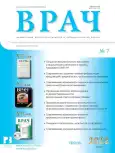Current possibilities for assessing and predicting the severity of community-acquired pneumonia
- Authors: Rubtsov Y.E.1, Goverdovsky Y.B.1, Mikhailov A.A.1, Tsepkova G.A.1
-
Affiliations:
- S.M. Kirov Military Medical Academy Ministry of Defense of Russia
- Issue: Vol 33, No 7 (2022)
- Pages: 19-23
- Section: Lecture
- URL: https://journals.eco-vector.com/0236-3054/article/view/114646
- DOI: https://doi.org/10.29296/25877305-2022-07-03
- ID: 114646
Cite item
Abstract
Late admission to the intensive care unit is associated with increased mortality in severe community-acquired pneumonia (CAP). The purpose of the study was to summarize current data on the possibilities of assessing and predicting the severity of CAP. The effectiveness of predicting the severity of CAP was evaluated using the most popular scales. The current procedures for assessment and prediction are focused on the early detection of respiratory and cardiovascular insufficiency and other types of internal organ dysfunctions. The inclusion of various biomarkers substantially increases the informative values of the scales. However, none of the scales can be an absolutely accurate tool and they should be considered as an additional aid in clinical practice.
Full Text
About the authors
Yu. E. Rubtsov
S.M. Kirov Military Medical Academy Ministry of Defense of Russia
Email: rubtsovyuri@yandex.ru
Candidate of Medical Sciences
Saint PetersburgYu. B. Goverdovsky
S.M. Kirov Military Medical Academy Ministry of Defense of Russia
Email: rubtsovyuri@yandex.ru
MD
Saint PetersburgA. A. Mikhailov
S.M. Kirov Military Medical Academy Ministry of Defense of Russia
Email: rubtsovyuri@yandex.ru
Saint Petersburg
G. A. Tsepkova
S.M. Kirov Military Medical Academy Ministry of Defense of Russia
Author for correspondence.
Email: rubtsovyuri@yandex.ru
Candidate of Medical Sciences
Saint PetersburgReferences
- Зайцев А.А. Внебольничная пневмония: возможности диагностики, лечения и вакцинопрофилактики в условиях пандемии COVID-19. Практическая пульмонология. 2020; 1: 14-20.
- Чучалин А.Г., Синопальников А.И., Козлов Р.С. и др. Клинические рекомендации по диагностике, лечению и профилактике тяжелой внебольничной пневмонии у взрослых. М., 2014.
- Chalmers J.D., Singanayagam A., Akram A.R. et al. Severity assessment tools for predicting mortality in hospitalised patients with community-acquired pneumonia. Thorax. 2010; 65 (10): 878-83. doi: 10.1136/thx.2009.133280
- Chalmers J.D., Taylor J.K., Mandal P.et al. Validation of the Infectious Diseases Society of America/American Thoratic Society minor criteria for intensive care unit admission in community-acquired pneumonia patients without major criteria or contraindications to intensive care unit care. Clin Infect Dis. 2011; 53 (6): 503-11. doi: 10.1093/cid/cir463
- Chalmers J.D., Mandal P., Singanayagam A. et al. Severity assessment tools to guide ICU admission in community-acquired pneumonia: systematic review and meta-analysis.Intensive Care Med. 2011; 37 (9): 1409-20. doi: 10.1007/s00134-011-2261-x
- Marti C., Garin N., Grosgurin 0. et al. Prediction of severe community-acquired pneumonia: a systematic review and meta-analysis. Crit Care. 2012; 27 (16): 141. doi: 10.1186/cc11447
- Fine M.J., Auble T.E., Yealy D.M. et al. A prediction rule to identify low-risk patients with community-acquired pneumonia. N Engl J Med. 1997; 336 (4): 243-50. doi: 10.1056/NEJM199701233360402
- Lim W.S., Baudouin S.V., George R.C. et al. BTS guidelines for the management of community acquired pneumonia in adults: update 2009. Thorax. 2009; 64 (Suppl 3): 1-55. doi: 10.1136/thx.2009.121434
- Brown S.M., Jones B.E., Jephson A.R. et al. Validation of the Infectious Disease Society of America/American Thoracic Society 2007 guidelines for severe community-acquired pneumonia. Crit Care Med. 2009; 37 (12): 3010-6. doi: 10.1097/CCM.0b013e3181b030d9
- Charles P.G., Wolfe R., Whitby M. et al. SMART-COP: a tool for predicting the need for intensive respiratory or vasopressor support in community-acquired pneumonia. Clin Infect Dis. 2008; 47 (3): 375-84. doi: 10.1086/589754
- Espana P.P., Capelastegui A., Gorordo I. et al. Development and validation of a clinical prediction rule for severe community-acquired pneumonia. Am J Respir Crit Care Med. 2006; 174 (11): 1249-56. doi: 10.1164/rccm.200602-177OC
- Зайцев А.А., Овчинников Ю.В., Кондратьева Т.В. Анализ клинико-диагностических возможностей инструментов оценки тяжести и прогноза внебольничной пневмонии у пациентов молодого возраста из организованных коллективов. Пульмонология. 2014; 5: 67-72. doi: 10.18093/0869-0189-2014-0-5-67-72
- Халимов Ю.Ш., Рубцов Ю.Е., Гусев Р.В. и др. Критерии тяжести внебольничных пневмоний у военнослужащих (диагностическая значимость). Современные проблемы науки и образования. 2014; 6: 1187-92.
- Рубцов Ю.Е., Халимов Ю.Ш., Гайдук С.В. и др. Новые возможности оценки тяжести внебольничных пневмоний у военнослужащих. Вестник Российской военно-медицинской академии. 2019; 1 (65): 50-5.
- Овчинников Ю.В., Зайцев А.А., Синопальников А.И. и др. Внебольничная пневмония у военнослужащих: тактика ведения и антимикробная терапия. Военно-медицинский журнал. 2016; 337 (3): 4-14. doi: 10.17816/RMMJ73539
- Jiang J., Yang J., Jin Y. et al. Role of qSOFA in predicting mortality of pneumonia: A systematic review and meta-analysis. Medicine (Baltimore). 2018; 97 (40): 12634. doi: 10.1097/MD.0000000000012634
- Middleton D.J., Smith T.O., Bedford R. et al. Shock Index Predicts Outcome in Patients with Suspected Sepsis or Community-Acquired Pneumonia: A Systematic Review. J Clin Med. 2019; 8 (8): 1144. doi: 10.3390/jcm8081144
- Sungurlu S., Balk R.A. The Role of Biomarkers in the Diagnosis and Management of Pneumonia. Clin Chest Med. 2018; 39 (4): 691-701. doi: 10.1016/j.ccm.2018.07.004
- Mira J.P., Max A., Burgel P.R. The role of biomarkers in community-acquired pneumonia: predicting mortality and response to adjunctive therapy. Crit Care. 2008; 12 (6): 1-7.
- Халимов Ю.Ш., Рубцов Ю.Е., Язенок А.В. и др. Состояние тиреоидного статуса у военнослужащих с внебольничной пневмонией тяжелого течения. Фундаментальные исследования. 2014; 10 (8): 1587-90.
- Pereira J.M., Laszczynska O., Azevedo A. et al. Early prediction of treatment failure in severe community-acquired pneumonia: The PRoFeSs score. J Crit Care. 2019; 53: 38-45. doi: 10.1016/j.jcrc.2019.05.020
- Zhao L., Bao J., Shang Y. et al. The prognostic value of serum albumin levels and respiratory rate for community-acquired pneumonia: A prospective, multi-center study. PLoS One. 2021; 16 (3): e0248002. doi: 10.1371/journal.pone.0248002
Supplementary files






